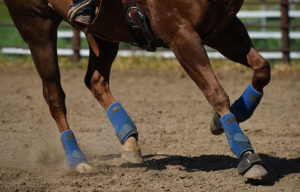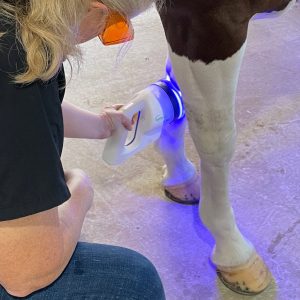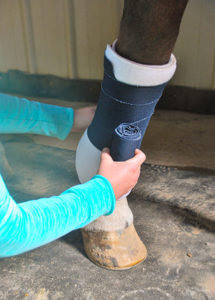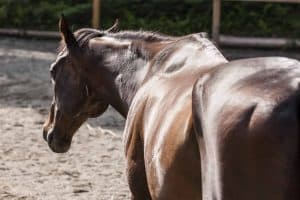Wound TLC
- Topics: Article, Insect Control, Wound Management
Horses are fight-or-flight animals notorious for injuring themselves. There are many types of wounds–from abrasions and bruises to puncture wounds and lacerations. Proper care as soon as possible after the wound occurs can often make a difference in how swiftly or completely it heals, and whether it becomes career-ending or life-threatening.
David Wilson, DVM, Dipl. ACVS, professor of equine surgery at the University of Missouri-Columbia, says wounds are usually categorized by site–whether they are on the head, body, or lower limbs–since these affect the horse in different ways and must be treated differently. So, let’s take an anatomic stroll through various types of wounds and what can be done by owner and veterinarian to take the best possible care of the injured horse.
DEFINITIONS
A bruise is a surface injury that doesn’t break the skin, but can cause damage to the muscle underneath, resulting in swelling due to bleeding under the skin or lymph (generally, clear fluid that circulates within the lymphatic vessels and contains fats, proteins, and specialized cells) seeping from the injured tissues. Applying cold water immediately after the injury occurs can help prevent or reduce swelling, since this slows the circulation in the area and constricts the small blood vessels.
An abrasion is scraped skin. It might bleed or ooze a little if the top layer of skin is removed. A soothing ointment can keep the area soft as it heals.
An incised wound is a clean cut or slice. If the cut is deep, it might bleed profusely if veins or arteries have been cut.
A laceration is a cut with torn or irregular edges. Healing might be slow due to extensive tissue damage.
A puncture is a small-diameter hole made by an object that penetrates the skin and deeper tissues. There’s always risk for damage to underlying tissues if the puncture is deep, and risk of infection if it closes up on the outside and leaves a pocket of contamination inside.
Head Wounds
These can include anything from slices to blows, and they might involve eyes, ears, mouth, sinuses, or the brain. The horse might stick his head through a fence, could be kicked in the head, or might go over backward and strike his head.
“Slices can occur when going through doorways, hitting the head on the top of a trailer, or anything else that peels off skin,” says Wilson. “If there’s no bone involvement, I tell people that no matter how old the wound is, no matter how ugly it looks, they should try to have it closed.”
The horse’s head heals well due to its excellent blood supply, and most head wounds can be sutured unless too much skin is missing.
“We often say that if wounds are more than a day old, they generally can’t be sutured because of contamination or dead/damaged tissue,” says Wilson. “If wounds are contaminated with manure and dirt, even very fresh wounds should not be immediately sutured, but this is not necessarily the case with head wounds. I’ve sutured head wounds that were more than a week old; you usually don’t lose those flaps like you do when suturing other parts of the body.”
CLEANING A WOUND
Cid Hayden, DVM, a draft horse breeder and veterinarian in Salmon, Idaho, says a fresh wound (generally less than three hours old, but climate and environmental contamination can make a difference in whether it’s considered fresh) can be considered contaminated, but not infected. “A contaminated wound merely has germs and dirt on the surface, and when you clean it you basically wash this away,” he says. “An infected wound has had time for bacteria to penetrate the tissue and start multiplying (or it was immediately contaminated with dirt and manure). You must not only clean the wound, but may need to put a drain into it when suturing.”
“If a wound is really dirty, I use a little iodine in warm water,” he says. “Dilute it until it looks like root beer. The water dilutes the iodine so it’s not harsh and irritating. Normal saline (sterile salt solution) is even better than water; you can put the iodine in that.”
A product commonly misused is hydrogen peroxide. It should not be used on raw tissue because it is extremely irritating. “Hydrogen peroxide should only be used to clean a grossly dirty/contaminated wound with caked dried blood, dirt, or manure,” says Hayden.
The bubbling, foaming action can penetrate through all the debris and loosen it up. It’s also effective when cleaning out a deep abscess or removing dried blood and dirt from surrounding hair on intact skin. It should not be used on any wound after suturing, since it delays healing and increases the chance for sutures to fail, he says.
Chlorhexidine (Nolvasan) is also used for cleaning wounds, and it can be diluted with water. “Both iodine and chlorhexidine are inactivated, however, if they come in contact with organic material like straw or manure,” says Hayden. “Chlorhexidine should never be used over a joint because it can be irritating to joint surfaces.”
Pressure from a hose is often adequate to clean out any dirt, debris, or discharge from a wound, and it is not irritating to skin and raw tissue. As long as it’s not a puncture wound (you don’t want to drive foreign material in deeper with the water pressure), cold water hosing is beneficial. The cold water is soothing, reduces pain and swelling, and flushes away material and contamination.
If a wound is oozing or draining and leaves a trail down the leg, face, or body, causing a scald (lost hair from the constant irritation), Tia Nelson, DVM, a veterinarian and farrier in Helena, Mont., recommends using Desitin (containing zinc oxide) or A+D ointment, both available at drugstores.
“Anything you can use on diaper rash will help protect the skin, and it doesn’t hurt the wound,” she says.
The biggest problem with head wounds is that they can extend into the sinuses or mouth. “The sinuses underlie the bone from the top of the eyes to halfway down the nose,” says Wilson. “Sinus involvement complicates repair and recovery, as does the condition of the underlying bone that’s been injured. If it’s in two pieces, you can usually wire or suture those back together. If it’s shattered, the repair may involve muscle transpositions (carrying of a flap from one situation to another without severing its connection entirely until it’s united at its new location) to cover the defect in the bone.”
Tia Nelson, DVM, a veterinarian and farrier in Helena, Mont., says horses are both amazingly tough–sometimes surviving in spite of tremendous odds–and very fragile. “Blunt trauma to the head can cause all sorts of injuries, from death to just the equivalent of a human black eye with swelling and bruising that needs only minimal care and time,” she says.
She recently treated a horse that collided with a power pole guy wire while being ridden bareback by a child. The horse pulled back and flipped over, throwing the child clear (and unharmed), but hit the side of his face. “The wound became emphysematous (distended because of retention of air under the skin),” says Nelson. “The owner was concerned because it sounded like Rice Krispies crackling when she touched his head.
“He’d done enough damage that we were concerned about possible fracture of the nasal bone, and we kept him on antibiotics and Bute for a while,” explains Nelson. “We kept his hay and water up off the ground so he wouldn’t have to lower his head–which would have increased the swelling.”
After two weeks the swelling resolved.
Any swelling on the lower part of the face creates risk for suffocation if the nasal passages are occluded, since the horse can’t breathe through his mouth.
A snakebite on the nose/face can quickly kill a horse, just from the swelling. If you frequently trail ride or camp where there are rattlesnakes, Nelson recommends taking along two pieces of regular garden hose that are six to eight inches long. “These can be inserted into the nostrils (after lubricating the ends) if the horse is bitten or has had any severe trauma to the front of the face and it’s swelling,” she says. “Make sure they extend up to where the bone begins.”
The bony part of the face will hold the passages open; it’s the soft tissue below the bone that will swell, she explains.
Eye injuries, or any wound near the eye or lids, should be seen by a veterinarian to make sure the eye isn’t damaged and that the lids can close normally. “If the eyelids can’t close, the horse is at risk for losing the eye because it will dry out,” explains Nelson. “A laceration through the lid should not be left to heal by itself.”
EMERGENCY FIRST AID
Disposable diapers are handy in your travel first aid kit (that accompanies you in your trailer, saddlebag, or anywhere far away from a veterinarian). They are absorbent and don’t stick to a wound, and they can be used as part of a pressure bandage. A diaper can be secured in place with any type of elastic bandaging material to help stop bleeding.
“Triple antibiotic ointments or Neosporin are good to have in your emergency kit,” says Tia Nelson, DVM, a veterinarian and farrier in Helena, Mont. “Another product I like is Derma GeL, made in Switzerland. It contains growth factors, is antifungal and antibacterial, and can be used as a spray or gel,” she says.
“The main thing to remember when applying first aid is to stay calm,” says Nelson. “Horses are very tuned in to us; we are their herd. Their life depends on what’s going on with the rest of the herd. If we are their herd and we panic, they panic.”
Wilson adds that lid lacerations can be severe and require immediate attention to prevent permanent damage. He says, “Often they can be sutured, though you may have to move some skin to close the defect.”
Corneas can be sutured, and cornea grafts might be necessary to cover or protect the cornea. Long-term results range from a simple scar with no sight loss to loss of the eye.
Ear wounds can be challenging; underlying cartilage damage can be a complicating factor. “Cartilage does not heal well because it doesn’t have a good blood supply,” says Wilson. “The affected cartilage may need to be cut away and may affect the final appearance of the ear. Once the traumatized tissues have been removed, ear lacerations can be sutured like any other wound. If skin or cartilage was lost, however, skin sliding techniques may be needed to move skin to the site, or skin grafts can be used to minimize scar tissue. If scar tissue develops, the ear may lose mobility and the horse won’t be as cosmetically pleasing.”
Lip wounds can also be difficult to repair. Often the injury will be in the corner of the mouth if the horse catches it on something and splits it upward, or it could be a puncture wound into the mouth. “Due to saliva and constant movement while eating, these wounds may not heal well on their own and need to be repaired,” says Wilson. They might require a three-layer closure, which means separate suturing of the inside the mouth, the subcutaneous tissues, and the outside skin to keep saliva from getting into the layers and breaking down the suture lines, explains Wilson.
Tongue injuries can result when a horse steps on the reins and jerks his head up, is tied with bridle reins and pulls back, or falls and hits his head and bites his tongue. The cut is usually across the tongue rather than lengthwise, and it can often be sutured.
“A cut tongue should be repaired, if possible, but if all else fails and you have to amputate the tongue, the horse seems to get along fine,” says Wilson. These horses learn how to maneuver food in the mouth. Many times you never detect the injury when it happens and just find the scar, or the horse might have part of the tongue missing, and you don’t know when it happened.
“Most of the blood supply is on the bottom; a large portion of the top can be cut and still have a reasonable blood supply,” says Wilson. “Even if the tongue is dangling from the bottom part, we can suture those pieces back together.”
Cid Hayden, DVM, a draft horse breeder in Salmon, Idaho, treats driving horses and draft horses and has seen tongue injuries when people put the lines on the hames (the curved wood or brass-plated steel pieces that fit around a harness collar) or hang them on the harness without unclipping them from the bit. If the horse catches the lines on something while being led to or from what they are pulling, the jerk on the bit might cut the tongue severely.
“A cut tongue will bleed profusely because of its abundant blood supply, but once the bleeding stops, you may not be aware of the injury unless you look in the horse’s mouth,” he says.
Body Wounds
“Upper body wounds generally heal (without affecting performance) no matter what you do–even if they are huge and ugly,” says Wilson. “Exceptions include puncture wounds that enter the abdomen or chest, and these are life-threatening. They are probably the most life-threatening injuries for the horse.”
A laceration or puncture that enters a body cavity (such as when a horse is impaled on a steel fence post) can damage internal organs.
Nelson has euthanatized several horses that were tied to metal T-posts, pulled back, then lunged forward and onto the top of the post. She tells of one horse that pulled a post over, then rushed forward and jammed it into his body between the shoulder and chest wall, and it came out behind his shoulder blade. The post went through muscle attachments and didn’t puncture the chest cavity, and the horse lived.
An “armpit” injury is also serious. If a horse gets halfway over a fence and becomes stuck, or if he gets a wire between the upper limb and the chest and takes off running, the wire in the armpit can sever all the muscles and enter the space beneath the shoulder blade. This can cause the area to act like a bellows when the horse moves, explains Wilson. The open space sucks air into the wound, forcing it underneath the skin. Air accumulation in the subcutaneous tissues of the body (emphysema) creates the crackling sound discussed earlier. The horse looks like a marshmallow for a couple weeks, then the swelling gradually resolves as the air is resorbed.
Most upper body wounds, from the elbow or stifle up, will heal nicely and generally won’t affect function. The skin might be laid open and need to be sutured or stapled if found in time. Closing the wound helps promote quicker healing with less scarring. Nelson has a 3-year-old filly she adopted as a yearling after the filly nearly cut off a front leg. “This was a horrible injury, but it healed well even though it was a week old when I got the filly and could not be repaired. We did a lot of cold water hosing to keep it clean,” says Nelson.
Some body wounds look horrific because so much skin has peeled off, but they often heal with very little scarring. “On the other hand, a tiny little puncture on the lower leg can end a horse’s career if it goes into a tendon,” says Nelson. How big and terrible a wound looks is not necessarily an indicator of how damaging it will be.
KEEPING FLIES OFF
Horses can get “fly strike” (myasis, or maggot infestation under the skin after flies lay eggs in the wound). “The thought of maggots in wounds is disgusting, but some people use maggots to clean out dead tissue,” explains Tia Nelson, DVM, a veterinarian and farrier in Helena, Mont. “The movement of maggots may also stimulate the living tissue, helping it heal faster.”
This is probably Nature’s way of cleaning and healing some types of wounds. “Personally, however, I’d rather stimulate the tissue with gauze and clean water,” says Nelson.
“Flies can be kept away from an unbandaged wound by using a product like Swat (a fly-repelling ointment) around the wound, or something that contains DEET,” Nelson adds. “Products containing pyrethrins (a pair of natural organic compounds with potent insecticidal activity) knock the flies down, but they come back. DEET can cause some skin irritation, but will keep the flies off. Frequency of application will depend on how soon flies return. If it rains and the next day the flies are back, you’d have to repeat it sooner.”
Limb Wounds
Wounds on the upper leg are often not as potentially serious as wounds on the lower leg. There are no muscles below the knee or hock, and there are no buffering tissues between the skin and the tendons, ligaments, bones, and joints. Nelson says the biggest mistake horse owners often make is in not recognizing the severity of wounds over a joint or tendon sheath.
“The future soundness of the horse may be at stake,” she says.
Wilson adds, “Often, if the wound is open and draining fluid, the horse may not be in pain if no other structures are affected.”
The lack of pain or lameness can be deceptive. It’s always wise to have a veterinarian look at any wound, but especially if it’s near a joint. It can be lavaged (flushed), cleaned, and closed before inflammation and infection become established.
Degloving wounds (involving the peeling off of skin) can be difficult to manage, such as on the hind cannon when the horse kicks through a fence and gets a leg caught at the hock. As he struggles to free himself, he strips the skin (and possibly the underlying tendons) from the cannon bone, from hock to fetlock joint.
“Anytime there are large portions of bone exposed, there is risk for having the outer shell of bone dry out and die, and the wound won’t heal until the dead bone is removed,” says Wilson. The horse will usually heal, but it can take six months to a year for full recovery. Generally, wounds on the front of the leg are not as worrisome as wounds on the back of the leg; the major tendons, ligaments, blood supply, and nerves are all at the back of the limb.
Lacerations over knees and hocks are difficult to treat. “These joints are almost impossible to immobilize,” says Nelson. “Horses tend to panic if you try to cast these joints … they wake up and find they can’t flex the limb. If a horse lacerates an area where there’s a lot of motion, be prepared for months of recovery. They will heal, but it takes a long time.”
Proud Flesh This exuberant growth on lower leg wounds is merely too much granulation tissue–the body’s response to fill in the hole. Hayden has dealt with many cases of proud flesh in 22 years of rural practice, typically when horses have tangled with wire fences.
“Granulation tissue covers the wound and is full of little blood vessels–feeding the skin edges as they grow across the wound and keeping lots of antibodies on the surface to fight off infection,” he says. “But you don’t want it to grow out beyond the surface of the w ound. There are countless home remedies for proud flesh, but none of them work very well.”
TETANUS
Whenever there’s a break in the skin and bacteria enter the underlying tissue, the horse should have a tetanus booster within 24 hours if his annual vaccinations are not up to date. “Tetanus bacteria are ubiquitous in the environment, and horses are very susceptible,” says Tia Nelson, DVM, a veterinarian and farrier in Helena, Mont. “You don’t always know when the horse might have an injury that could introduce this pathogen. A tiny puncture may end up killing the horse. If a horse was boostered in the spring against tetanus and gets injured later in the year, he does not need another booster (nor antitoxin).”
Tetanus antitoxin is produced by hyperimmunizing donor horses, then harvesting the antibodies. It is administered to unvaccinated horses to induce short-lived, immediate passive protection. The passive immunity usually lasts only two to three weeks.
The annual toxoid vaccination gives long-lasting protection. Antitoxin, however, binds to circulating toxins, gives very temporary protection, and can be dangerous. “It can, in some instances, cause disease that affects the liver and can kill the horse,” explains Nelson. “It’s much safer to keep the toxoid vaccinations up to date.”
Many traditional remedies are either caustic (they eat away the tissue) or astringent (they dry it up). Hayden explains that even though the remedies might retard proud flesh, they delay healing by damaging the skin edges that are trying to grow.
“Horsemen often worry that proud flesh will form on upper body wounds, but it’s just a lower leg problem,” he says. “Areas that don’t have underlying muscles are at risk, since there’s nowhere else for the excess tissue to go except outward. Any place there’s movement, such as near a joint, the wound is more at risk for proud flesh. The stretching and pulling of the wound at every step stimulates granulation tissue to grow faster. One of the worst places is a wound at the front of the hock.”
Wilson recommends using topical steroids in lower leg wounds that might be developing proud flesh. Products such as Panalog (a combination antimicrobial and steroid) are available as cream or ointment. “I generally don’t use medications on lower leg wounds; I prefer to just apply even pressure with a bandage instead,” says Wilson. “If excess granulation tissue develops, I trim it away and apply a topical steroid.”
Heel bulb lacerations “Anything that involves the coronary band will probably alter future hoof growth in that area,” says Wilson. Heel bulb and coronary band injuries might be from wire cuts or sticking a foot through a metal barn wall–slicing the side of the foot when the horse pulls it out. If blood and nerve supply to the foot are affected, this can compromise future athletic ability, and lack of blood supply slows healing.
“With this type of injury, we almost always bring the horse in and place him under anesthesia so we can thoroughly evaluate and clean the wound and make sure joints and tendon sheaths are not involved,” explains Wilson. “We then try to close the wound and apply a foot cast to keep it immobile. Wrapping the foot will not stabilize it enough. The more movement that occurs at the coronary band, the more it will be damaged, increasing the likelihood for abnormal hoof growth in the long term.”
Nelson says it’s difficult to immobilize other joints of the leg, but the hoof is easy to put in a boot cast to hold it still so it can heal without a big scar: “I’ve had some very nasty heel bulb lacerations that healed without any scarring of the hoof wall if they are sutured immediately and cast, and I have sutured coronary bands back together.”
Rope Burns/Road Rash
Any type of friction burn (from a rope, or from the horse sliding along the ground after a fall) can be deceptive. Even though it might not cut through the skin, friction produces heat and can damage underlying tissues, just like a burn from fire.
Fragments of rope, dirt, or stones might be embedded in the damaged skin, causing irritation and delaying healing. A serious friction burn needs veterinary attention, a lot of aftercare, and might take a long time to heal.
A small-diameter hard twist or nylon rope can saw through the skin. “If you’ve ever had a horse pull away from you with a nylon rope and zing all the skin off your fingers, you realize how serious it can be,” says Nelson. The thinner the rope, the more likely it can do catastrophic damage.
Infection
If foreign material and/or bacteria are aspirated into a body wound along with air (such as in a deep armpit laceration), infection can spread throughout the body, says Wilson. “Abscesses can develop at sites far from the original injury,” he says. “Fortunately, infections are usually localized rather than being systemic, but your veterinarian may put the horse on antibiotics due to the risk of sucking in bacteria.”
Some wounds that don’t get adequate early care or were heavily contaminated become infected. “If a wound is still draining two weeks after the injury or initial treatment, or there’s pus coming out of the wound, or the swelling is not resolving, it should be reevaluated by your veterinarian,” states Wilson. “We usually go back and repeat all the initial procedures. We clean and debride the wound, removing any foreign material and dead tissue that might be present.” Joint lavage or antibiotic perfusions might be needed.
Nelson says it’s important to pay attention to clinical signs: “If the horse goes off feed or isn’t drinking, doesn’t want to travel (walk around), or has a high fever, call your veterinarian.” These signs could indicate a serious infection. On the other hand, some of the things horse owners worry about are not a problem. Horses produce a lot of fibrin in a wound–a thick, yellowish, stringy material that can look like pus. “It’s part of the healing process” explains Nelson. “Pus, by contrast, often has a bad odor and is more green than yellow, and sometimes has a bloody tinge.”
If there’s pus, the area is usually swollen and hot or has some other indications of infection.
Bleeding
Whenever a horse is bleeding profusely, get control of the horse and get control of the bleeding. Don’t put yourself at risk. “Apply pressure to the wound if the horse will let you, but don’t get hurt trying to save a horse’s life,” says Nelson. If the horse is losing blood fast enough that you can’t stop the bleeding, you are not going to keep him from dying by getting hurt yourself.
Apply a pressure bandage as soon as possible; don’t try to clean the wound. “Even if there’s a chunk of wood or other foreign material in it, first control bleeding,” advises Wilson. “If a pressure bandage doesn’t stop the flow, just keep layering until there’s enough pressure to slow it. Usually, this will take care of bleeding unless there’s a major artery involved–such as the inside of the top of a leg.”
Control the bleeding, then take the horse to a veterinarian.
Remember that a horse can lose a lot of blood before it becomes life-threatening. It might look like a lot when it’s running down his leg or in a puddle on the ground, but unless an artery is spurting like a hose, you have some time.
Take-Home Message
Remember, the size or depth of a wound is not an indication of severity, and neither is blood loss. Discuss some of these common wounds with your veterinarian before they happen in order to formulate a plan to apply emergency first aid until professional help arrives, and to know when it is necessary to call your practitioner.
HYPERBARIC OXYGEN THERAPY
Oxygen is a significant portion of the air we breathe and a crucial component of processes that fuel the body tissues: it’s needed for cell building. Scientists developed an effective procedure for helping many ailments heal more swiftly based on the idea that for optimum healing, more oxygen than normally contained in our bodies can be beneficial.
Hyperbaric oxygen therapy (HBOT) involves the use of chambers in which the patient is exposed to concentrated, pressurized oxygen. At normal atmospheric pressure only a small amount of oxygen is dissolved in blood plasma and a limited amount is carried by the hemoglobin in red blood cells. Merely increasing the amount of air breathed (even if it’s pure oxygen) can’t improve oxygen delivery via hemoglobin. But with increased pressure, the oxygen level in blood plasma increases, with higher delivery to all body tissues.
In a chamber full of pure oxygen under pressure, more oxygen is physically dissolved in the blood. It is more readily utilized by the body than is the oxygen carried by hemoglobin. HBOT is being used in humans and animals to speed healing of soft tissue injuries, including difficult wounds. Once a day, the horse is put into a chamber for 30 to 90 minutes, the number of days depending on the condition being treated.
Hub and Kirsten Johnson at KESMARC (an equine rehabilitation center in Versailles, Ky.) use HBOT for treating many kinds of injuries and severe infections. “The main problem is that sometimes we don’t get to treat these horses until a problem is long-standing,” says Hub Johnson. “Everything else has been tried, the owners have given up, and the horse is brought here as a last resort. But we’ve had a lot of success in spite of this.”
Getting extra oxygen to the tissues reduces swelling and helps salvage damaged tissue that would otherwise die, says Johnson.
Written by:
Heather Smith Thomas
Related Articles
Stay on top of the most recent Horse Health news with















